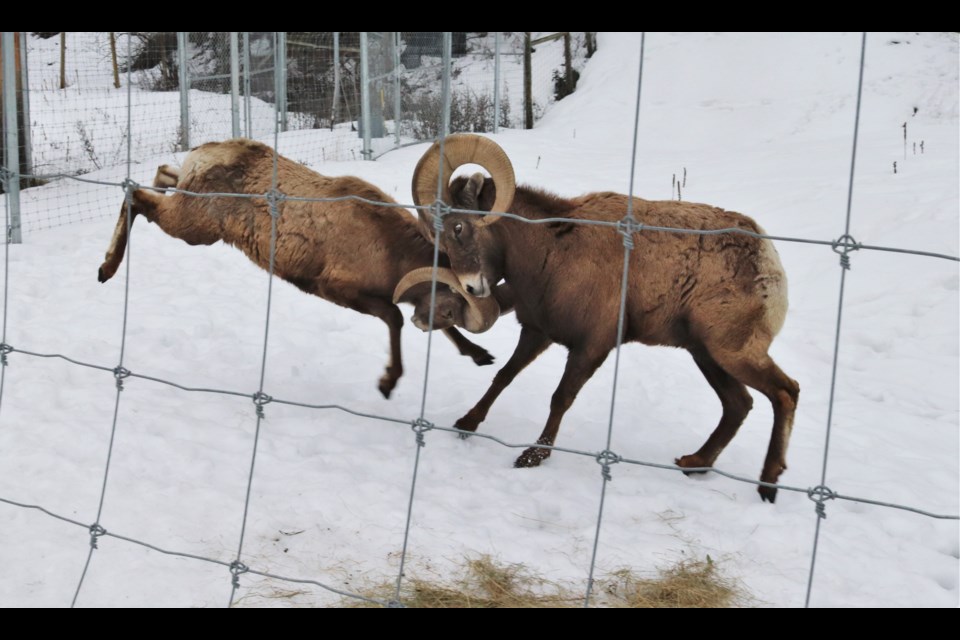As the coldest season begins its last stand, animals at the B.C. Wildlife Park are still enjoying some of the last bits of winter.
For the park's trio of bighorn sheep, it's not a bad time to say hi, as winter is when their most famous behaviour takes place, starting in December.
"We see a lot of extra activity, so they're running up and down the hill, they're checking the air to see if there are any females in and about," says zookeeper Danielle Rogers. "There's a lot of headbutting where they actually crack their heads together."
The three resident bighorn sheep are all male and related. The oldest, Q-tip, is six years old. The other two, Robson (four years old) and Elbert (three) are his sons.
As Q-tip is the largest, he and Elbert don't butt heads too often (literally), but Rogers says that's just beginning to happen. While the three look close in size, she explains Elbert hasn't been big enough to safely take on Q-tip. Robson, being in the middle, is the prime choice for both his brother and father.
"(Elbert's) horns are getting to a bigger size where he's actually able to make contact with Q-tip without injuries happening," Rogers says.
The sound is one people in Dallas might recognize, as the sharp crack has been heard by plenty of neighbours, she adds.
In fact, the sheep are so active, the caretakes have to watch their weight to make sure they're staying healthy. During the rutting season, they're so interested in finding a female, they even notice the scent of one of their neighbours.
Those neighbours? A pair of mountain goats named Cloud and Gerard. Six-year-old Cloud occasionally catches the attention of the sheep. She, unsurprisingly, gets her name from the fact her fine white fur looks like a cloud (and she spends time part of time higher up than any other animal at the zoo, climbing the hillside at the back of the goat pen).
Gerard is the old goat, turning 17 this spring. At that age, he requires a little bit more care.
"As Gerard is getting older we see a little weakness in his hind, so what we want to do is keep him moving but not necessarily do any hard work to get his food," Rogers explains. "What we tend to do is put a little bit of the food down lower in the enclosure and then the food we want Cloud to get we put a little higher up."
Because Gerard is the dominant goat, there's little competition for his meals.
Both the sheep and goats are prepared for Kamloops winters. During the cold snap in January, the park staff took some precautions for Gerard (including using donated Christmas trees to create a windbreak), because of his age, but Cloud was fine.
Not far away is perhaps the most well known hoofed animal at the park, Thunder the elk, who lives with eight female elk. Zookeeper Melany Leontowich says Thunder's antlers, which regrow a bit bigger each year, require a special feeding spot.
"His antlers fall off in march and regrow every single year," she says. "Last year's antlers, when they fell off, were 13.5 lbs each."
She adds that seeing an elk in the wild with such a large set would be quite rare. The antlers aren't just tossed when they do fall.
"We can use them for enrichment for other animals but mostly in the last few years we use them for educational purposes," she says. "We use them for elk feed talks, so people can hold them and see how big they are."
Thunder's pen mates are three older, mother elks and their five daughters. The mothers are all around 19 years old, while the daughters are nine or 10. As Thunder's antlers would be affected if he was neutered, he's had a vasectomy so the herd stays manageable.
That means he still goes through a rutting season with a bugle call. If you're in the park during the fall, Leontowich says you can hear his bugle call.
"It's a fantastic sound to hear in September," she says, describing the sound as "like a table saw."
While most of the other mammals bed down to some extent for the winter, like the badger or raccoons, Quilla the porcupine stays active for the colder months. Zookeeper Larissa Deneault (Setse7) takes care of Quilla, making sure the spikey resident gets exercise, including a climb down here cage's wall.
"They are pretty hardy in the winter," she says of porcupines, which are the second-largest rodent in North America (after beavers).
"On really cold days she isn't wandering out as often," Deneault adds. "She also gets a heat lamp as a supplemental heat source."
Quilla is a senior, by porcupine standards, at 13. Most wild porcupines don't make it past seven. However, Quilla is still active, toddling along to get to food Deneault tucks around her space. When she's in there, the zookeeper has to be careful of the animal's quills, of which there are around 30,000 at any given time.
Deneault notes that the idea that porcupines can throw or fire their quills at someone is a myth, though if a porcupine shakes its body (like a dog after a swim), some quills can be tossed.
That's it for the mammals of the B.C. Wildlife Park. We'll wrap up our winter wildlife series next week with a look at the birds.

